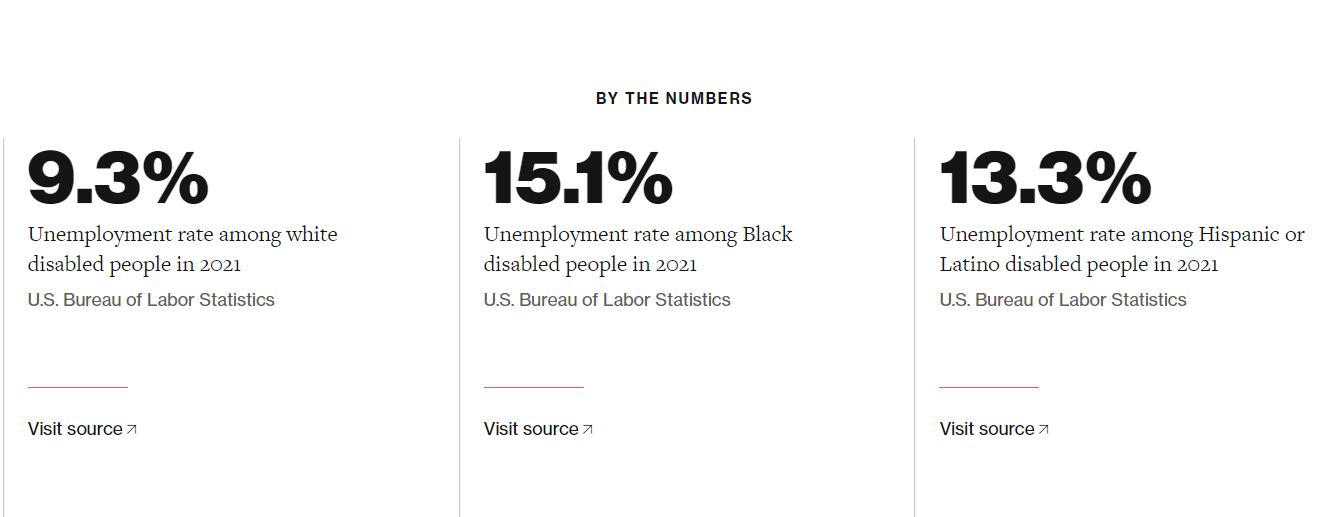As we announced in June 2020, we are committed to dismantling systemic inequality in recruiting. Part of this commitment involves quarterly updates surrounding our efforts.
In Q4 of 2022, we took time to build awareness and educate ourselves as a team on the Persons with Disabilities (PWD) community. Specifically, this involved WHAT opportunities and HOW we can bring more employment options to them AND equally as important, what we can do differently and better in our job postings to extend an invitation to apply. We chose this focus for October and November to coincide with National Disability Employment Awareness Month (NDEAM).
We’d like to share with you some highlights that stood out to the team:
Disability awareness
We started with a video from DC.gov on disability sensitivity training:
Did you know that in 2021, the unemployment rate among PWD was double what it was for those without a disability? Or that PWD is the most unemployed group in the US? I didn’t either, and as a result of this quarter’s awareness and education, we’ve taken action to do our part in communicating and offering accommodations to create accessibility. Ultimately, as we know the more diverse a team, the more productive. (Source: https://www.americanprogress.org/article/removing-obstacles-for-disabled-workers-would-strengthen-the-u-s-labor-market/)

From Center for American Progress, “Removing Obstacles for Disabled Workers Would Strengthen the U.S. Labor Market”
In the same article, we learned that “people ages 65 and older account for half of the population with a disability and 17.9 percent of employed disabled workers. As previously documented by the Center for American Progress, people ages 65 and older accounted for only 35 percent of the 1.2 million increase in the number of people with a disability in the civilian noninstitutional population in 2021.”

The same article from CAP shows the unemployment statistics by race and ethnicity.
Additionally, we found this helpful guide on appropriate terms to use about disability: https://nda.ie/publications/attitudes/appropriate-terms-to-use-about-disability/
“Invisible” disabilities
Next up, we began learning about invisible disabilities through a conversation with Arjun Devgan, Global VP, Customer Success at Amplitude, that our very own Evelyn Kwong recorded for her podcast series, Building Culture. In this episode titled “From Invisibility to Accessibility,” Arjun covers his experience navigating and succeeding in the professional world with a disability. Why this is important? The podcast reveals various barriers Arjun was up against and he discusses approaches and solutions for creating an inclusive work environment – from revealing a disability to how employers should respond.
Our biggest “Ah Ha’s”: Most accommodations are either free or under $500. I’m not sure about you, but I had a misconception on how much money an accommodation would take and in transparency, that scared me. 75% of people choose not to disclose; it’s on us to create a more people-first vs. compliance-first culture. And last but not least, we learned that hybrid has been a game changer for the PWD community because it has allowed for more accessibility and video/visual accommodations rather than just conference calls.
Shifting from a compliance-first vs. people-first culture is free to do and speaking up empowers others to do so, too.
Meaningful changes in hiring for PWD
The following week, we watched a TEDx video: Why I hired a workforce no one else would | Randy Lewis | TEDxNaperville.
Randy Lewis, former Walgreens executive, shares the inspiring story of his son and how that impacted hiring at his company.
These were some salient discussion points and key takeaways from our team conversation after watching the video:
- Is it about results or style? What do we pay attention to, complaining or dancing?
- Walgreens showed the PWD community they wanted to hire them – that’s different from simply distributing a job posting
- ATP: Ask The Person (WOW, great reminder)
- Never assume what people can and cannot do (No comment needed)
- The importance of taking time to see things through others’ eyes
- We need to open the door wider
Last, but certainly not least I want to share some recruitment-specific resources from JAN (Job Accommodation Network). They have an entire library of role-playing videos, but we felt these two below captured REAL examples in the workplace:
JAN Hiring an Individual with Anxiety and Stuttering Disorder
This conversation demonstrates how a hiring manager should respond when someone reveals a disability and accommodating for such during the interview process.
JAN Deciding Whether to Disclose a Disability During an Interview
Helpful perspective on what it’s like for a candidate to disclose a disability.
In addition to the actions mentioned earlier, we’ve also:
- Revised our job posting template to specifically invite PWD to apply
- Added invitations to share an accommodation during the interview process on all of our interview confirmation templates and those that we set for our clients
- Forged a partnership with www.disabledperson.com, a 501(c)3 non-profit organization with a mission to reduce the high unemployment rate of individuals with disabilities. This partnership is the first with a third party or “recruitment agency”. Thank you for taking a chance on us, Mike!


